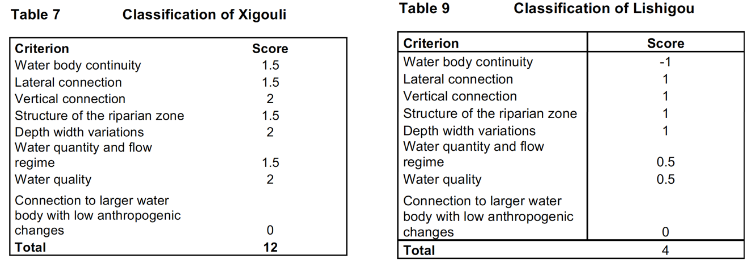
Ecological Assessment and Classification for the Status of a River around Beijing
Details
Introduction
Once the decision has been made to restore a Small Waterbody (SWB) to close-to-nature functionality using green engineering methods, a range of questions come up: What is a “natural waterbody” in the context of the local watershed, what are the most suitable, least invasive methods to restore the SWB and how should the degree of improvement of the SWB be measured.
Reference River
In order to restore a SWB to close to nature conditions it is necessary to have a natural river as an accurate reference model or a standard to assess the current status of modified rivers against and choose the appropriate interventions for rehabilitating the SWB.
Finding a natural stretch of a river can be a difficult task in a landscape inhabited and modified by people for as long as in China, especially around Beijing. It might take a while and the cooperation with local bureaus to find such stretches, which are often in more inaccessible areas. It is strongly recommended that an expert familiar with river restoration and ecology is consulted to ensure that the properties of the reference river can be applied to the modified SWB. However, some possible criteria are proposed in Annex 1.
Pre-Restoration Assessment
In order to know the status of the modified river certain information needs to be obtained, depending on the restoration goal. As the goal in this method (link: see “Restoration Methods for Small Waterbodies”) is to restore the river to as natural conditions as possible it is necessary to gather data about the ecological status as much as about the hydromorphological and physiochemical status. This is different from the current approach for monitoring surface water quality in China, which doesn’t collect ecological and hydromorphological data due to its stronger focus on the river’s suitability for human use instead of the more holistic ecosystem functions. The recommended data that could be obtained is closely modeled after the water framework directive (WFD) in the EU. For a more detailed list of EU-WFD Elements for the classification of the ecological status of a river, refer to Annex 2.
The data needs to be taken from both the reference river and the river that needs restoring. Generally speaking, both hydrological and morphological data can be obtained through transsectional walks and surveys along the water body, while water quality should be measured and categorized according to current Chinese environmental quality standards and corresponding methods. It should be noted that, while desirable, biological data is generally fairly expensive and time consuming to collect, and might therefore have to be neglected. That being said, particularly for future monitoring purposes at least an initial analysis of the biological situation of a river can tremendously help assessing that same river later during monitoring.
Once the data has been gathered it should be scored. During the SWB restoration efforts in Beijing a scoring system from 1 (best) to 2 (worst) was used, where a reference water body had to achieve a score of at least 14 across all categories. (p.20 T2) However, this can be modified according to the local situation. An example of the scoring of a respectively “natural” and “modified” can be found below for rivers Xigouli and Lishigou:
| Fig. 1 Xigouli can be classified as a „non-modified small waterbody“, while Lishigou is a fairly disturbed waterbody |
Monitoring
After base scores for the rivers have been created and measurements to fix the problems been designed and implemented the now “restored” river will need monitoring to ensure the treatments are really restoring the ecological functionality of the river. This can be done with the same scoring system used initially, but frequencies and priorities might differ. For example, the morphological status of the new river is unlikely fluctuate, while it’s biological elements might be more sensitive to environmental changes. The table below shows the general frequency and recommended methods for monitoring different components.
Conclusion
The assessment and monitoring of the ecological status of a small water body are essential components of small waterbody restoration and should be a component in any SWB restoration program.
Sources
Binder, W., et al. (2015). "Ecological restoration of small water courses, experiences from Germany and from projects in Beijing." International Soil and Water Conservation Research 3(2): 141-153.
Group, G. C. (2007). Annex 20: Small Water Ecology and Bioengineering; Feasibility Study Desertification Control Programme Northern China: "Watershed Management on Forest Land".
Group, G. C. (2015). Watershed Management on Forest Land Beijing, GFA Consulting Group.
Group, G. C. (2007). Annex 10: Wetlands; Feasibility Study Desertification Control Programme Northern China: "Watershed Management on Forest Land".
Li, H., et al. (2015). Sustainable Watershed Management Practices in The Miyun Reservoir Watershed of Beijing, China, Beijing Forestry Society.

